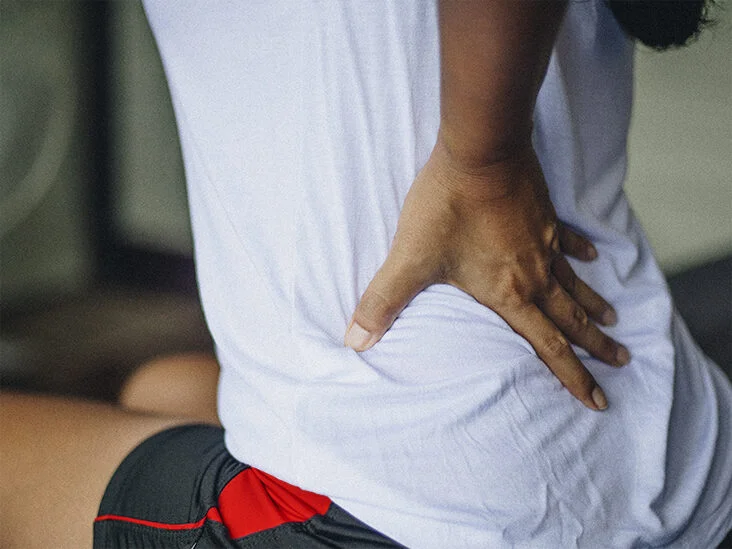Experiencing back pain can often be an uncomfortable and disconcerting experience. However, when it’s localized to the lower left side, the frustration can increase even further, with sufferers often grappling with questions such as ‘Why just on one side?’ and ‘What does this mean for my health?’ In this blog post, we’ll dive deep into the world of lower left back pain, uncovering its common causes, and exploring a variety of treatment options. Also, will be suggesting effective ways to prevent it.
Contents
What Does Pain In The Lower Back Left Side Mean?
 Pain in the lower left side of the back can arise from various conditions and causes. Often, it’s associated with musculoskeletal issues, poor posture, or sudden awkward movements. That puts stress on the lower back muscles and ligaments. The location of the pain can suggest problems with the structures on the left side of the body. Such as the left kidney or parts of the colon.
Pain in the lower left side of the back can arise from various conditions and causes. Often, it’s associated with musculoskeletal issues, poor posture, or sudden awkward movements. That puts stress on the lower back muscles and ligaments. The location of the pain can suggest problems with the structures on the left side of the body. Such as the left kidney or parts of the colon.
However, it’s crucial to remember that not all lower left back pain is a cause for concern. Transient discomfort can occur from overexertion or maintaining a particular position for too long. But persistent or severe pain can indicate more serious underlying conditions. Therefore, if the pain is severe, and persists, seeking medical attention is advisable.
What Are The Symptoms Of Lower Left Back Pain?
Lower left back pain can present itself in various ways depending on the underlying cause. And symptoms can range from mild to severe. Here are some common symptoms that may accompany the pain:
- Localized Pain
This is pain that remains in the lower left back without radiating to other areas. The pain could range from a dull ache to a sharp, stabbing sensation.
- Radiating Pain
Pain may start in the lower left back but spread to other areas. Such as the buttocks, thighs, or down the left leg. This is often due to nerve irritation or compression, as seen in conditions like sciatica.
- Muscle Stiffness or Tightness
The muscles in the lower back might feel tight or tense. And this stiffness can limit your range of motion or make certain movements painful.
- Weakness or Numbness
If nerve compression is involved, you may experience weakness, tingling, or numbness in your lower back, hip, leg, or foot.
- Changes in Bowel or Bladder Function
In some cases, especially with conditions like cauda equina syndrome, lower back pain may be accompanied by loss of bowel or bladder control, which is a medical emergency.
- Fever or Other Signs of Infection
If the pain is due to an infection such as a kidney infection, you might also have a fever, chills, sweats, or other signs of systemic infection.
These symptoms can vary greatly based on the root cause of the pain. It’s important to take note of any accompanying symptoms and seek medical attention. Particularly if the pain is severe, and doesn’t improve with rest.
Why Do I Have Lower Left Back Pain?
 There could be numerous reasons why you’re experiencing lower left back pain. Here are some common causes:
There could be numerous reasons why you’re experiencing lower left back pain. Here are some common causes:
- Muscle Strain or Sprain: This is one of the most common causes of lower back pain. It can result from heavy lifting, overuse, sudden movement, or an accident. Strains are injuries to muscle fibers or tendons, while sprains are ligament injuries.
- Herniated Disc: Your spine has intervertebral discs that provide cushioning. A herniated or slipped disc occurs when the inner gel-like substance leaks out and presses on a nerve, causing pain that can radiate down the leg.
- Sciatica: If the sciatic nerve, which runs from the lower back down each leg, becomes irritated or compressed. Then, it can cause lower back pain, which may radiate down the leg.
- Kidney Conditions: Kidney stones or infections could also cause pain in the lower left back. As the left kidney is located in this area.
- Arthritis: Osteoarthritis can affect the lower back, leading to stiffness and pain.
- Skeletal Irregularities: Conditions such as scoliosis (a curvature of the spine) can lead to back pain later in life.
- Gynecological Conditions: In women, certain gynecological issues like endometriosis, ovarian cysts, or uterine fibroids can cause lower left back pain.
It’s crucial to remember that lower back pain is common, and often improves with self-care strategies. However, if your pain is severe, persistent, or accompanied by other worrying symptoms, seek medical attention promptly to ensure you receive the right diagnosis and treatment.
How Do You Treat Lower Left Back Pain?
Treatment for lower left back pain largely depends on the underlying cause. However, here are some common approaches:
Rest and Activity Modification
When you initially experience lower left back pain, particularly if it’s related to a specific activity like lifting a heavy object or a sudden awkward movement, the first step is often to rest and allow the body to heal. This doesn’t mean you need to stay in bed or avoid all activities. In fact, some light movement can help prevent stiffness and promote healing.
However, you should avoid activities that cause or worsen the pain, such as heavy lifting or bending and twisting movements. As the pain improves, gradually increase your activity level, but be careful to avoid re-injury.
Over-the-Counter Pain Relievers
For many people, over-the-counter pain relievers can provide significant relief from lower back pain. These medications include non-steroidal anti-inflammatory drugs (NSAIDs) like ibuprofen (Advil, Motrin) or naproxen (Aleve). That reduces inflammation and relieves pain, and acetaminophen (Tylenol) can ease the pain.
These medications should be taken according to the package instructions unless a doctor advises otherwise. While generally safe for short-term use, they can have side effects, especially with prolonged use. So it’s important to use them judiciously.
Physical Therapy
Physical therapy can be a vital part of recovery and prevention of recurring lower back pain. A physical therapist can design a personalized exercise program that targets the specific muscles that need strengthening and stretching. This often includes exercises to strengthen your core (the muscles around your abdomen and back) as they play a key role in supporting your spine.
The therapists can also teach you correct posture and body mechanics for daily activities. That can help prevent future episodes of back pain. Physical therapy for back pain may also include other treatments such as massage, heat or cold therapy, ultrasound, or electrical stimulation.
Heat or Cold Therapy
 This is a simple yet effective method to alleviate lower back pain. Cold packs can help reduce inflammation, numb the painful area, and slow nerve impulses, interrupting the pain signals. They are particularly useful in the first 24-48 hours following a back injury. On the other hand, heat therapy can stimulate blood flow and promote healing by bringing nutrients to the affected area.
This is a simple yet effective method to alleviate lower back pain. Cold packs can help reduce inflammation, numb the painful area, and slow nerve impulses, interrupting the pain signals. They are particularly useful in the first 24-48 hours following a back injury. On the other hand, heat therapy can stimulate blood flow and promote healing by bringing nutrients to the affected area.
It also helps soothe stiff joints and relax muscles, which can reduce back spasms. Using a warm bath, heating pad, hot water bottle, or heat wrap that provides continuous, low-level heat is an effective method. However, it’s important to avoid applying heat or cold directly to the skin. Instead, wrap the heat or cold source in a cloth or use a commercial product designed for this purpose.
Surgical Intervention
If the lower back pain is due to a specific anatomical problem and conservative treatments have not worked, your healthcare provider may recommend surgery. The type of surgery will depend on the underlying issue. For example, if a herniated disc is pressing on a nerve and causing severe pain, a surgeon might perform a discectomy to remove the portion of the disc causing the pressure.
Spinal fusion can stabilize the spine when there’s movement-associated pain from worn-out or injured discs or joints. It’s important to understand that surgery comes with risks, and the decision should be made after thorough discussions with the healthcare provider.
It’s essential to remember that any treatment should be undertaken under the guidance of a healthcare professional, who can recommend the best treatment options based on the diagnosis and individual health condition.
How Can I Prevent This Pain?
Preventing lower left back pain largely revolves around maintaining a healthy lifestyle, practicing good posture, and protecting your back during physical activities. Here are some strategies to help prevent this type of pain:
- Maintain a Healthy Weight
Extra weight, particularly around the midsection, shifts your center of gravity forward and puts additional strain on your back muscles. Maintaining a healthy weight can prevent this extra stress on your back.
- Stay Active
Regular physical activity exercises that strengthen your core, can help prevent back pain by keeping your back muscles strong and flexible. Activities like walking, swimming, or cycling can also help keep your back healthy.
- Practice Good Posture
Good posture is crucial both when sitting and standing. When sitting, choose a chair that supports your lower back or use a lumbar roll or cushion. Keep your knees and hips level and your feet flat on the floor. When standing, keep your weight balanced on your feet and avoid slumping or slouching.
- Lift Smart
If you’re lifting something heavy, let your legs do the work. Keep your back straight and bend only at the knees. Hold the load close to your body and avoid lifting and twisting at the same time. If the object is too heavy, don’t try to lift it alone—get help.
- Quit Smoking
Smoking reduces blood flow to your lower spine, which can contribute to spinal disc degeneration. It also slows healing, so back pain may last longer.
Remember, while these strategies can help prevent back pain, they may not be effective in all cases. If you’re dealing with recurring or persistent back pain, it’s essential to seek medical advice.
Conclusion
Lower left back pain, though common, can greatly affect your daily life. It can stem from various causes, including muscle strain, disc herniation, kidney conditions, and more. While minor discomfort can often be managed through rest, over-the-counter pain relievers, heat or cold therapy, and physical therapy. But severe or persistent pain may require more intensive treatments.
However, it’s crucial to remember that any persistent back pain should not be ignored. Consult with a healthcare professional to properly diagnose the cause. And determine the best treatment plan for your specific situation.
If you’re experiencing Back pain, physical therapy for back pain at PhysioMantra can help: Book an online physical therapy session.



